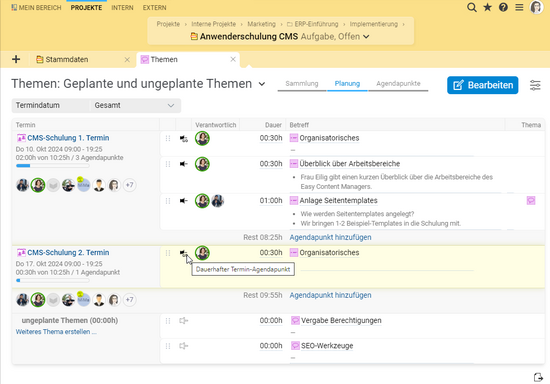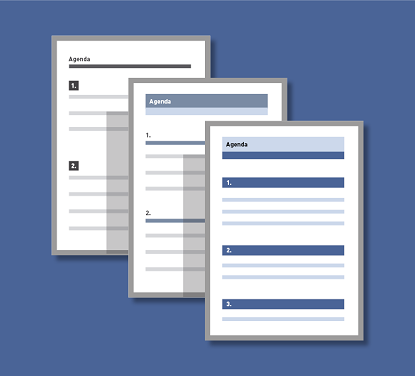07/04/2022 - Articles
Creating a meeting agenda: 7 tips for your efficient meeting planning
No agenda, no successful meeting. A meeting agenda serves as a guide for all meeting participants and helps the facilitator establish a goal-oriented discussion guide. If this is your first time facing the task and you're asking yourself "How do I create a meeting agenda?" or "What actually makes a good meeting agenda?" you shouldn't miss this article. Here are seven valuable tips to help you get the best possible results from your meeting.

Meeting Agenda Tip 1: Goal Definition

Follow the ideal: one meeting, one topic, one goal. After all, a meeting can only be effective if the goal can be defined at all and has been defined and communicated to all participants beforehand. So, already when compiling the agenda, determine which goal or which insight the meeting is supposed to produce. The selection and sequence of the agenda items is based on this objective.
Therefore, at the beginning of each meeting, also plan a fixed agenda item in your agenda where you briefly pick up all participants and inform them what the goal of the meeting is. Briefly clarify the questions:
- Where are we in relation to topic XY?
- Why is it important that we address it?
- What decisions regarding XY do we want to have made after this meeting?
Meeting Agenda Tip 2: Set Meeting Time and Place

Every meeting needs a venue and a time. Of course, this is equally true for remote meetings or hybrid meetings. In these cases, a URL to a virtual meeting room in Jitsi, Zoom, Webex or Teams replaces or supplements the information about the physical meeting room. When inviting all participants to a meeting, make it clear whether the meeting is a face-to-face meeting, an online meeting as a video conference or a hybrid meeting, and, if applicable, which participants will take part and in what form.
From the topics themselves and the event form derive the requirements for IT and other inventory that you need to provide as part of the meeting preparation. For example, you should plan more time for the planning and preparation of a hybrid meeting, as you need to ensure ideal sound and image conditions for both physically present and digitally connected participants.
Meeting Agenda Tip 3: Too many cooks spoil the broth...

... and too many opinions hinder decisions. Therefore, only those people should be present in each meeting who are indispensable for achieving the meeting goal. If it is a fixed group of participants, e.g. a team weekly, the topics should be selected so that each participant can contribute something or derive essential knowledge for his future work.
Every meeting therefore needs a competent moderator who is respected by all participants. His or her task is to ensure that
- each topic is dealt with in the allotted time,
- discussions proceed in an orderly fashion,
- digressions are stopped immediately,
- each participant contributes his or her point of view,
- ideas and further input are noted at the agenda item, and
- a clear result is achieved and recorded.
The moderator should not necessarily be the boss or an executive. If the supervisor is in charge of the meeting, this can lead to some participants making a particular mark and pushing their opinions to the forefront, while others withdraw and want to attract as little attention as possible. Instead, a moderator should be appointed from within the team. It is also advisable to pass on the role at regular intervals and to invest in moderation or rhetoric training in the medium term.
Meeting agenda tip 4: Fewer topics, but binding duration

Often topics are packed into a meeting that do not concern all participants. The result: Half of the participants are bored, while the other half shamble from sub-topic to sub-topic and get lost in detailed discussions. Therefore, when creating the meeting agenda, you should make sure that you only include topics that really concern everyone. If this is not possible, we recommend dividing the meeting into several sections:
- In the first section, topics that are relevant to everyone are discussed.
- In the second section, only those people whose presence is required for the following topics remain in the room.
In the case of such a division, you should already clearly communicate in the agenda from when to when the presence of each individual participant is required.
Whoever proposes a topic should at the same time indicate how long the topic should be discussed ("time boxing"). Define the duration of your meeting in advance and fill this time frame with the proposed topics in descending order of priority: the most important topics first, less important topics or topics concerning only some of the participants at the end.
Agenda planning should therefore be carried out by a person who can best assess the urgency of the various topics. Furthermore, the person must also have the necessary authority to be able to push or delete less important topic proposals.

No chance for blatherers and windbags! Reduce the resource time by scheduling the topic blocks tightly one after the other according to the specified duration and do not allow for a buffer. It is the responsibility of the person in charge to bring the agenda item to a successful conclusion within the specified time.
Meeting agenda tip 5: Make expectations recognizable

To make it clear from the outset how much interaction is expected to work through a meeting topic, it makes sense to categorize the agenda items. For example, the IDE principle is recommended:
- Information (I): Participants should be informed about a specific topic. Questions are to be expected, but no discussion is to take place.
- Discussion (D): A problem is presented. To find a solution or a decision, the participants should work out proposals and discuss them together.
- Decision (E -"Entscheidung" in German): Different decision options are presented. Participants are asked to choose one option without much discussion or questioning.
If discussions and decisions are expected, all participants have time in advance to deal mentally with the issues at hand.
At Projektron, the categorization of agenda items is primarily based on the number of participants in the meeting and the quantity of topics. The weekly sales meeting, for example, serves primarily to bring all participants up to date, i.e. to provide information (I). Discussions and also decisions usually take place beforehand in smaller meetings. In the weekly marketing meeting, on the other hand, the proportion of discussion (D) and decision (E) is significantly higher. The aim here is to obtain different opinions, gather creative input from all sides, discuss the proposals and make joint decisions on this basis.
Meeting Agenda Tip 6: Record key results, objections, objections and alternative proposals
![Meeting Agenda Tip 6: Record key results, interjections, objections and alternative proposals [Translate to Englisch:] Meeting-Agenda Tipp 6: Zentrale Ergebnisse, Einwürfe, Einwände und Alternativvorschläge festhalten](/fileadmin/_processed_/3/e/csm_meeting-aganda-tipp-6_5cdb197c64.png)
During the course of the meeting, continuously document all significant contributions, alternative proposals and results. The moderator - or a separately appointed secretary in the case of larger numbers of participants - should make this as transparent and comprehensible as possible. Ideally, this information should be noted directly at the relevant agenda item and all participants should be allowed to view the transcripts both during the meeting itself and afterwards. Document resolutions and agreements on an ongoing basis during the meeting, giving all participants the good feeling that they are making rapid progress and achieving good results.
It is useful for everyone present to be able to review the results of a meeting afterwards. The advantages:
- No one has to take notes themselves during the meeting.
- If necessary, concrete results and requests for action can be tracked at any time.
- Participants who are absent, for example due to illness, can update themselves independently and do not need a time-consuming private update afterwards.
Meeting Agenda Tip 7: Delete "Other"

It is often found at the end of a meeting agenda as the last item on the agenda: "Other". The idea behind this item may well be a noble one: Each participant should be given the opportunity to bring up the topics that are burning under their nails and discuss them together.
However, this is not in the spirit of a structured and efficient meeting agenda. In fact, inviting participants to choose their own topics carries some risks:
- Participants sometimes bring up topics that had nothing to do with the actual focus of the meeting.
- Topics introduced by participants harbor a high potential for conflict and discussion, which can easily break the time frame.
- Spontaneously raised topics are often presented in a one-sided, tendentious manner and are not subject to any objective corrective, since the moderator has no opportunity to prepare for the topic in terms of content.
But how do you still guarantee that every employee gets a chance to speak and raise their concerns? Allow each team member to propose a topic. As the meeting organizer, you then decide during agenda planning which topics fit the content of the next meeting and which topics could be an addition or even an enrichment. Clear software helps to manage topic suggestions wisely and simplify planning.
Items that do not fit into an agenda can be collected and scheduled on a special date with a fixed time frame. Some topics may also be better suited for a personal, bilateral discussion or for discussion in a meeting group with a different composition.

Tip for your meeting agenda: Use a meeting planning software! If you design an individual meeting agenda template in a software, you automatically ensure that you consider all necessary planning steps in the future and you standardize your planning process at the same time.
Meeting Agenda Checklist
Use this checklist to see if your meeting agenda will achieve your goals.
 | 1. The goal of the meeting is clearly stated. |
 | 2. Each agenda item corresponds to a clearly defined topic. |
 | 3. Each topic is formulated in a comprehensible way. |
 | 4. The topics are sorted in descending order of priority. |
 | 5. Each agenda item has a fixed duration. |
 | 6. Each topic has a responsible person. |
 | 7. Context documents such as presentations or charts are directly linked to the respective topics. |
 | 8. Breaks are scheduled for meetings lasting more than 60 minutes. |
 | 9. All participants must be present for each topic on the agenda. If not, they are not assigned to the respective topics. |
 | 10. The scheduled meeting duration does not exceed the pre-determined meeting duration. |
 | 11. All participants have access to the agenda from the time of the meeting invitation and to the agenda and results after the meeting. |
 | 12. The results of the meeting can be noted directly in the agenda. |
Software Matters: Planning Meeting Agendas with BCS
If you are already a Projektron BCS user, you already have a flexible and powerful agenda planning tool. Here, all team members can enter desired meeting topics for a task into a topic collection at any time. During meeting planning, the meeting organizer takes individual topics from this clearly arranged topic pool and assigns them to the agenda of a meeting plan.
Now quickly assign the participants and specify the estimated duration of each meeting topic and the agenda planning is done. If individual participants' appointments overlap with the scheduled meeting time, BCS warns them and helps them find a more suitable time slot. The meeting date including the agenda can be called up transparently and clearly for all participants.
When selecting a suitable planning software, be sure to look for
- comfort functions,
- compact views,
- short click paths and
- ease of use.
All this will save you time and nerves in your future meeting planning, as well as tedious clicking back and forth between topic collection, planning views and appointment calendars. In BCS, for example, the entire operation of assigning topics or meeting participants is drag-and-drop. If a meeting topic is to be defined as the permanent topic of every future appointment in a meeting series, you only have to spend a single click.
Just as easy
- add new meeting topics,
- adjust the scheduled duration of the topic block,
- remove a topic from the agenda of an appointment, or
- delete the topic completely from the topic pool.
With the topic scheduling features in BCS, you can create your own meeting agenda template in no time. This ensures standardized and efficient meeting planning, as well as transparency, since all participants can submit topic suggestions and view the agenda in advance.
Meeting agenda: motivation and efficiency thanks to structure
A team meeting without an agenda is possible, but is ultimately a waste of time and resources. If the efficiency and insight gained from meetings are regularly low, the motivation of all participants usually suffers permanently and leads to increasing disinterest and even demotivation. With a well thought-out and tight meeting agenda you have a powerful tool against meeting fatigue in your hand. An easy-to-use software such as Projektron BCS will help you considerably in making your work organization and teamwork more efficient and transparent. Give your meetings structure and meaning: motivation, efficiency and results will be your reward!

About the author
Like all teams at Projektron GmbH, the marketing department organizes and plans all of its meetings, appointments, and discussions using Projektron BCS. Regular marketing meetings are held weekly in a hybrid format so that all team members from different company locations can participate. The meeting agenda is an indispensable feature for planning topics, for orientation during the meeting and for recording the results in a transparent manner for all participants.











